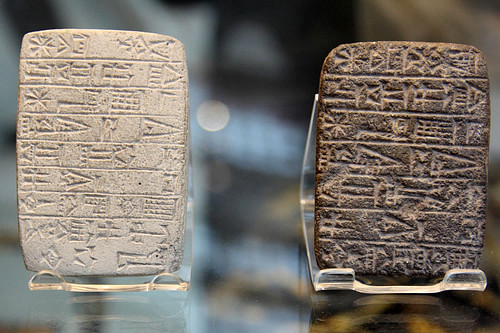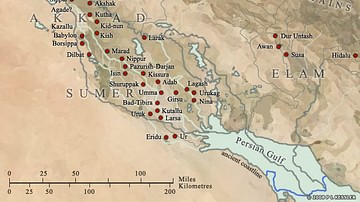
The Sumerian language was spoken in southern Mesopotamia before the 2nd millennium BCE and was the first language to be written in the cuneiform script. It is an isolate language meaning we know of no other languages that relate to it ancestrally. Although there are some theories that Sumerian is a member of the Uralic languages like Hungarian and Finnish, or other language families, this is a minority view with insufficient evidence to make a definite claim. The language was spoken in a region where Semitic languages were also spoken, particularly Akkadian, and it eventually fell out of use in favor of those languages by the turn of the 2nd millennium BCE. However, a literary form of the language continued to be written for another 2000 years, and it also had notable influences on other languages of the region with respect to their lexicon, grammar, and writing.
Historical Development of the Language
Little is known about when Sumerian-speaking people arrived in southern Mesopotamia, assuming they did not originate there. Either way, from a very early period a multilingual environment existed in southern Mesopotamia, which included languages like Sumerian, an early form of Akkadian, other Semitic languages, and Hurrian. Some scholars have posited the possibility of an otherwise unknown substrate, or influencing language of the area, due to the presence of words of unknown origin in Sumerian writings. It has been demonstrated, however, that these words either originated in other known languages, are compounds in Sumerian, or words common to many languages of no clear origin.
The first instance of the language in writing is from a group of texts dating to the Uruk IV period (c. 3200 BCE). Most of these are administrative texts, but some are wordlists used for scribal education. It has been challenged that these texts are indeed Sumerian, due to the fact that ideograms abound, which can be read in any language. For instance, three strokes along with a depiction of an ox could be read as “three oxen” in English, “drei Ochsen” in German, “tres bueyes” in Spanish, etc. The meaning of the writing would not change. However, the presence of phonetic complements as well as phonetic spellings that cue the reader to an actual pronunciation makes it almost certain that the language was indeed Sumerian. Around 400 years later, the next group of texts we have come from Ur c. 2800 BCE. Again, these are mostly administrative texts together with a number of wordlists for scribal education.
Our knowledge of Sumerian literature, in fact the earliest known literature, comes alive during the Early Dynastic Period III (EDIII) c . 2500 BCE, especially at the sites of Fara (ancient Shuruppak) and Abu Salabikh. Here we gain the first instances of such works as the Kesh Temple Hymn, the Instructions of Shuruppak, and Lugalbanda and Ninsun (the parents of Gilgamesh), which broke through the boundaries of the practical realm of economy and administration, and delved into the sphere of mythology and cosmology . Even though these texts are difficult to read, we can ascertain literary themes like the formation of the world, divine temple building, and other divine activities, sometimes of an adult nature. In these texts, we also encounter a large number of names of scribes and functions which are Akkadian in origin, suggesting that the two languages were very intermixed, as stated above. This was the time of the Sumerian's greatest worldly influence, as evidenced by texts outside the Mesopotamian realm from Mari, Ebla, Tell Beydar, and Tell Brak which utilized the cuneiform script for Sumerian as well as their local Semitic languages.
We do not have a lot of evidence for Sumerian writing during the Sargonic period (c. 2300 – c. 2100 BCE). Scribes were centrally trained in Agade and then sent out to help conduct the affairs of every part of the realm, but they used Akkadian as their language, giving Sumerian a backseat. Even so, there were still local towns using Sumerian writing to run the local administration.
There was somewhat of a resurgence of Sumerian writing during the Ur III period (c. 2100 – c. 2000 BCE) as the first kings of this period, Ur-Namma and Shulgi used Sumerian cuneiform in their administrations. However, at this stage the written language would not have reflected any spoken vernacular. In the realm of literature, Shulgi replaced the earlier ED III mythological tradition with a new scribal curriculum introducing such genres as royal and divine hymns and songs. This was also the period where such famous works like The Curse of Agade and the Law Code of Ur-Namma were first composed. Contemporary with Ur-Namma was Gudea, the king of Lagash/Girsu who is famous for being the focal point of texts on cylinders and statues. In one account, the city god Ningirsu came to him in a dream and commanded him to build the Eninnu (lit. “50 House”) temple at Girsu, which he of course dutifully did.
By the Old Babylonian Period (c. 2000 BCE), most scholars are in agreement that people had stopped speaking Sumerian entirely (if not earlier). However, even though the language ceased to be a spoken one, it was revitalized by Old Babylonian scribes as a literary one. In fact, most of the Sumerian literature that comes down to us is from this period. As such, there is much debate over how in tune to reality the Old Babylonian versions were to the previously living language. Many of these texts come from southern Babylonian sites like Ur and Nippur but only before and during the reign of Samsu-iluna under whom a rebellion led to the abandonment of Nippur. In northern Babylonia, the tradition was not interrupted until the invasion of Mursili I (c. 1595 BCE). Some famous texts either initially written in this period or copied from an earlier period include the Sumerian King List, Lamentation of Ur, Inanna's Descent into the Underworld, and the hero myths of Enmerkar, Lugalbanda, and Gilgamesh.
Writing
Sumerian is written in the cuneiform script. In fact, it is the first language we know to be written using cuneiform and most likely cuneiform was developed for use by this language. The script was originally written using ideograms, symbols which express an idea rather than a word or sound, and thus can technically be understood in any language. As the script developed though, Sumerian scribes attributed syllabic values to the signs based on how the word sounded in the language. For instance, a picture of a mouth would represent the word 'ka' and so the sign could now represent the syllable 'ka' in any word containing that syllable.
The writing system of Sumerian has the principles of polyphony and homophony. Polyphony means that some signs have multiple syllabic values, for instance the DU sign could be read either 'du', 'ra2', 'ša4', etc., each having different but often related meanings. Homophony means that there are multiple signs having the same syllabic value. You may have noticed the use of subscripts (2) in the sign values. This is because syllables like 'ra' had multiple sign renderings like RA , the aforementioned DU, and others. Incredibly, some syllables had more than 10 different signs representing them.
This principle of homophony and the fact that one syllable in Sumerian often comprises the entire word have led some scholars to believe that Sumerian contained a tonal system. How can there be so many homophones without there being some other feature to distinguish them? Countering this notion, other scholars have noted that these single syllables often differ by their final consonant, which falls out of pronunciation at the end of the word e.g. the sign for ox 'gu4' has another value 'gud', the 'd' falling out when the word is final. Another suggestion is the potential existence of consonant clusters, which the writing system had no means of representing.
Dialects?
There was an interesting system of sign value variation which occurred only during the ED III period. This is commonly referred to as UGN or UD.GAL.NUN as the signs spell out. This manner of writing is characterized by atypical readings for certain signs. For example, the signs UD.GAL.NUN had the anomalous reading of diŋir.en.lil2 which would reference the god (diŋir) Enlil, which had nothing to do with the typical sign reading. There are a number of instances of these irregular readings but it seems to fall out of practice after this period.
Eme-sal is commonly referred to as a dialect of Sumerian as opposed to eme-gir15 or the “main dialect” of Sumerian. The writing of eme-sal is limited to ritual texts, particularly the lamentation texts for gala-priests, and the words spoken by certain goddesses, although in other places these goddesses speak eme-gir15. Because the sign SAL can have a reading as munus meaning “woman”, scholars have posited that eme-sal is a genderlect or special dialect for speech by women. However, the sign SAL also has the reading sal which means “thin” or “soft” and could simply refer to a special variant for the goddesses or ritual-performing priests as stated before. Another suggestion put forth is that the gala-priests were eunuchs, but there is no evidence for castration in ancient southern Mesopotamian culture.
The Legacy of Sumerian
As stated above, the Sumerian language enjoyed a resurrection during the Old Babylonian period as a literary and liturgical language. The scribes in this period considered the language as essential for maintaining the traditions of a very old period, and wanted to recapture an archaic time of magic and legend. After this period ending c. 1595 BCE, the scribal usage of Sumerian decreased significantly. The repertoire of texts was reduced, particularly the royal/divine hymns of the Ur III period, and even the ones that continued were written only in bilingual renditions with Akkadian and other languages. However, Sumerian was still being studied in scribal schools and even chanted in liturgy through the Persian and Hellenistic periods. There even exist student exercise tablets with cuneiform on one side and Greek on the other. The last known cuneiform tablet was an astronomical work dating to 75 CE from Babylon, but it is possible that the script finally fell out of use later than this.
Today, Sumerian is taught at only a select number of universities around the world. In total, probably not more than a few hundred people have a working knowledge of the language and there is still much debate over even the basics of the grammar. Even top scholars in the field are uncertain of the meanings of certain passages. Sumerian offers a challenging yet fascinating puzzle on the lives and literature of those who first accomplished the task of immortalizing their words in writing. It is a truly intriguing language reflecting the intriguing people who wrote it down.








